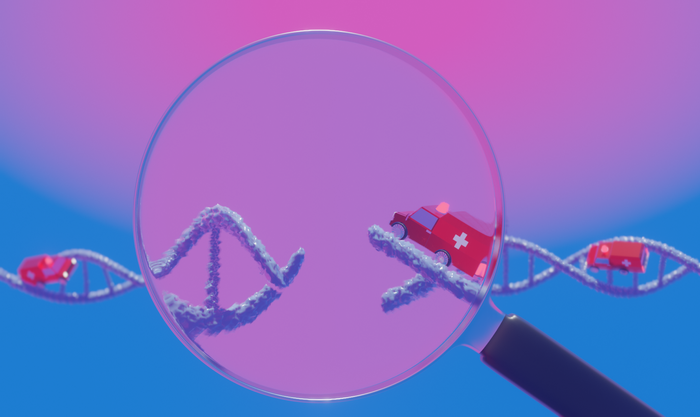Many powerful genome editing approaches must create breaks across both strands of the DNA double helix and rely on the cell’s own DNA repair machinery to introduce desired changes in the sequence. If a cell fails to repair these DNA double-strand breaks (DSBs) efficiently and accurately, the genome becomes unstable, and the cell dies.
Cells have evolved two pathways to repair DSBs called non-homologous end joining (NHEJ) and homology-directed repair (HDR) with unique genetic components. Yet, how a cell decides to repair DSBs and the factors involved remain unclear.
To enable a better understanding of DSB repair, scientists have now developed a new approach called Repair-seq that pairs CRISPR-based genetic screens with DNA-site-specific deep sequencing to profile the range of mutations produced at targeted DNA sites by different genome editing tools. This new approach helps to understand how DNA repair pathways work to introduce programmable changes in the DNA sequence.
The study, conducted in the laboratories of Britt Adamson, PhD, assistant professor at the department of molecular biology at Princeton, Jonathan Weissman, PhD, professor of biology at the Massachusetts Institute of Technology and an investigator with the Howard Hughes Medical Institute, and Cecilia Cotta-Ramusino, PhD, formerly at Editas Medicine and currently vice president of technology development at Tessera Therapeutics, is published in an article in the journal Cell, titled, “Mapping the Genetic Landscape of DNA Double-strand Break Repair.”
Rodolphe Barrangou, PhD, Distinguished Professor of Food, Bioprocessing and Nutrition Science at the North Carolina State University and the chief editor of The CRISPR Journal, who is not involved in the study comments, “This study critically addresses the second of two parts for genome editing: CRISPR has rendered specific targeting and cleavage straightforward, so the key challenge is now to truly understand the diversity of repair pathways and outcomes that can be triggered.”
“Repair-seq is a beautiful marriage of technological savvy and biological insight,” said John Doench, PhD, director of research and development in the Genetic Perturbation Program at the Broad Institute, and who was not involved with the work.
“We’ve known for a long time that the mechanisms involved in fixing broken DNA are essential for genome editing because to change the sequence of DNA you first have to break it,” said Adamson. “But those processes are incredibly complex and thus often difficult to untangle.”
“Editing with double-strand breaks has been the bread and butter of genome editing for a long time but making intended changes without unwanted mutations has been an enormous challenge,” said Jeffrey Hussmann, PhD, first author on the study. “We set out to understand the mechanisms behind as many of the induced mutations as possible, reasoning that this could help us optimize the system.”
The researchers reasoned that simultaneously measuring the genetic determinants of a broad range of DSB repair outcomes would help studies on DSB repair. “With this goal in mind, we developed Repair-seq, a high-throughput method that combines locus-specific deep sequencing with CRISPR-interference (CRISPRi)-based genetic screens to measure the effects of thousands of genetic perturbations on the spectrum of mutations produced at targeted DNA lesions,” the authors noted.
Repair-seq allows researchers to parse the contributions of different pathways to repair specific DNA lesions by simultaneously profiling how hundreds of individual genes affect mutations produced at damaged sites. Researchers can then generate mechanistic models of DNA repair and learn how those mechanisms impact genome editing.
Using Repair-seq the team study the repair of DSBs induced by two programmable nucleases—Cas9 and Cas12a, generating maps of edited sequences. “Systematic exploration of these maps isolated processes responsible for common nuclease-induced mutations and revealed unexpected roles for canonical DNA damage response genes,” the authors noted.
The authors also applied Repair-seq to study DSB repair with different external repair templates (oligonucleotide donors). “This effort identified a range of genetically distinct processes by which template sequences are incorporated at breaks and demonstrated that Repair-seq is a flexible approach for uncovering how diverse genome editing technologies interact with endogenous repair processes.”
In two companion studies, the authors used Repair-Seq to identify the genetic determinants of base and prime editing outcomes, helping develop more efficient and precise editing tools.
Analysis of data from Repair-seq experiments has identified granular details in known repair pathways and has identified new pathways that highlight the complexity involved in double-strand break repair. The data unearthed from this work is available to others who can use it to further investigate genes and pathways involved in DNA repair.
“Together, these data demonstrate the broad utility of Repair-seq and provide a foundation for further exploration of DNA repair pathways,” the authors said. Moving forward, the team will continue to improve the platform and apply it to additional genome editing technologies.
“We see Repair-seq as a tool that allows you to take a detailed picture of what genome editors are doing inside cells and then very quickly assess, ‘Is this a landscape in which I can find design principles that will help improve the tool?’” said Adamson. “We are really excited to explore future applications.”
“These tools will be critical to map, understand and eventually manipulate the repair pathways responsible for CRISPR-based editing outcomes,” Barrangou adds. “As we progress towards the clinical deployment of CRISPR technologies, we must now fully ascertain the mosaicism of editing outcome so we can precisely and predictably manipulate genomes.”



